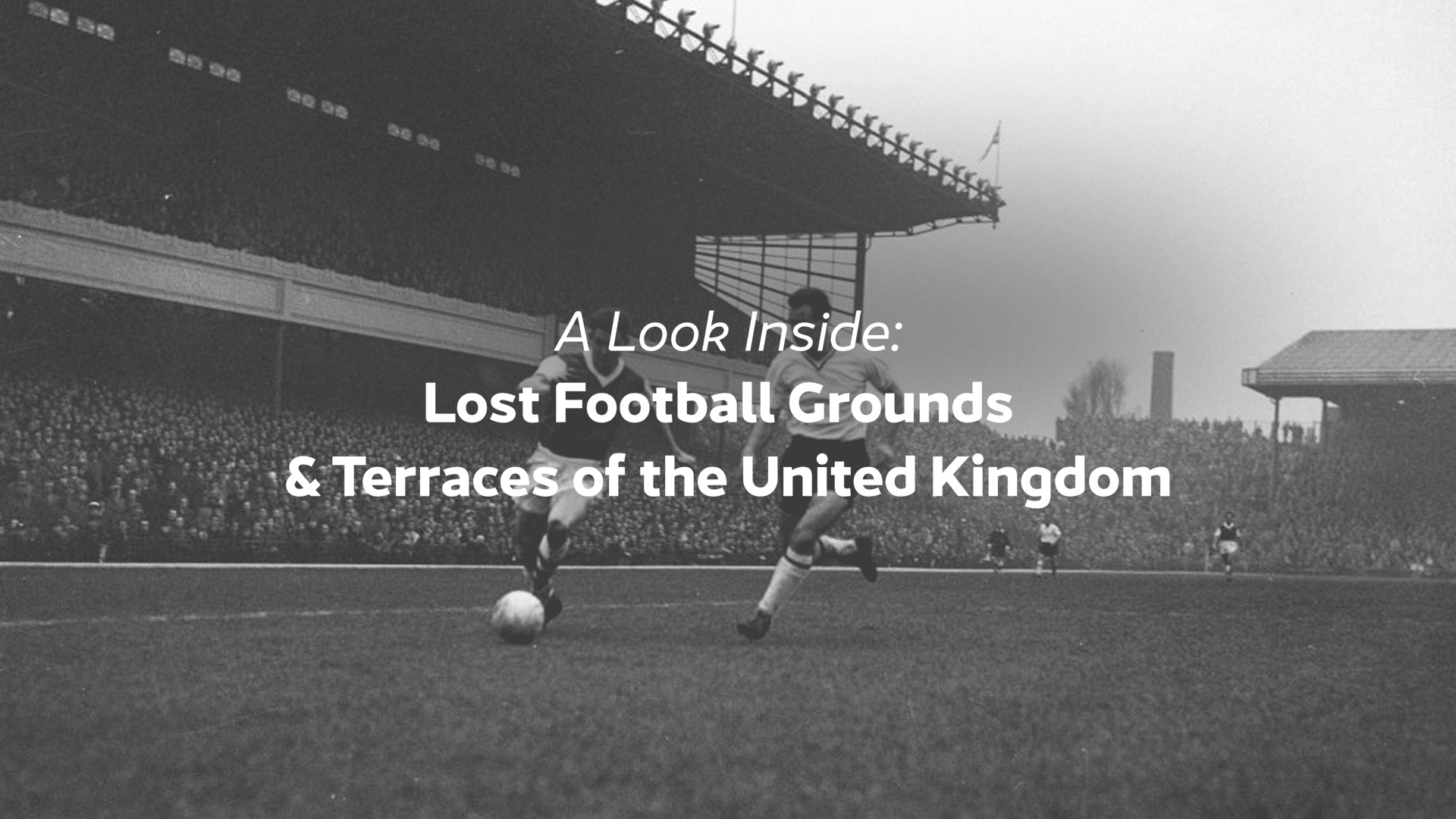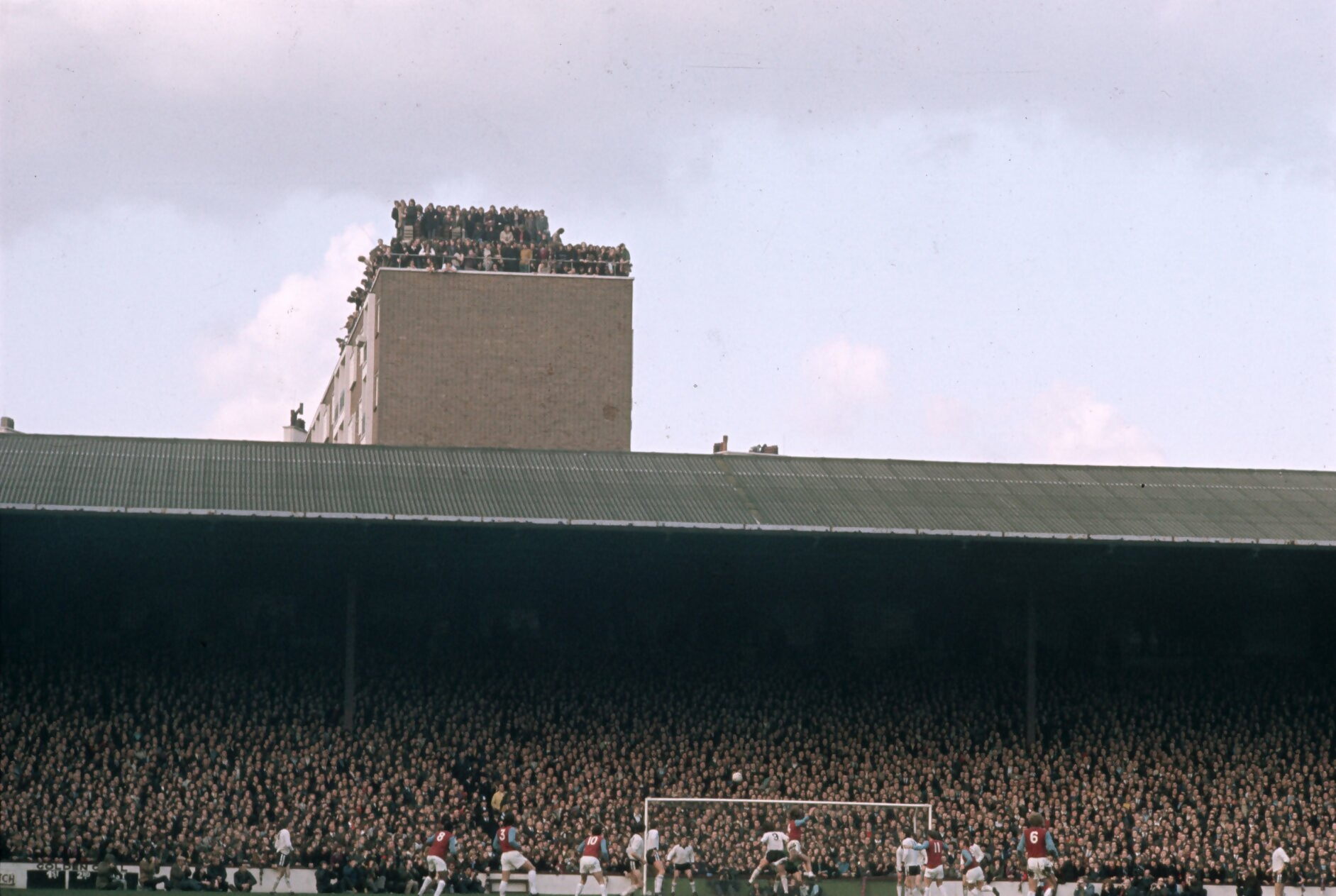
How can you not be romantic about football? The pictures may have gotten better, the stadiums bigger, the boots flashier, and the mullets fewer and further between, but looking back at the photos of what once was, fills you with a longing for yesteryear.
It just ain’t like it used to be – ask around, and you’ll find I’m not alone in feeling this sentiment. Look at the 200,000-odd members of the Lost Football Grounds and Terraces of the United Kingdom Facebook group. It’s only been in existence for three years but has already become a thriving community, celebrating a bygone era of the nation’s most popular sport.

West Ham vs Hereford United 14th February 1972

An aerial view of Stamford Bridge, home of Chelsea Football Club, circa 1988 in London, England.
As the group’s title suggests, the focus is on the stadiums themselves, but players, teams and matches all feature prominently.
Daily posts and discussions make it a place to reminisce. That’s what it’s about, really. Seemingly all photos are met with enthusiasm and generate some conversation – be it recalling a player, a performance, an away day or a cup tie.
It’s incredible how a grainy old stadium photo can bring back memories.

Fans at Leyton Orient FC vs Derby County FC match, which ended in a draw, London, UK, 4th January 1975.
![We take a look inside the Lost Football Grounds and Terraces of the United Kingdom Facebook group – an online space for hundreds of thousands of footy fans to celebrate their favourite old amphitheatres. How can you not be romantic about football? The pictures may have gotten better, the stadiums bigger, the boots flashier and the mullets fewer and further between, but looking back at the photos of what once was, fills you with a longing for yesteryear. It just ain’t like it used to be – ask around and you’ll find I’m not alone in feeling this sentiment. In fact, just ask the 200,000 odd members of the Lost Football Grounds and Terraces of the United Kingdom Facebook group. It’s only been around for three years, but has already become a thriving community, celebrating a bygone era of the nation’s most popular sport. Photo 2, 3 The focus is, as the group’s title suggests, on the stadiums themselves, but players, teams and matches all feature prominently. Daily posts and discussions make it a place to reminisce. That’s what it’s about, really. Seemingly all photos are met with enthusiasm and generate some sort of conversation – be it recalling a player, a performance, an away day or a cup tie. It’s incredible how a grainy old photo of a stadium can bring back memories. Take this comment, beneath a photo of Leyton Orient’s Brisbane Road ground: ‘My first ever football match 1970 aged 4. Dear old Dad took me v Millwall. I remember a small punch up at Gardens End, and a very loud woman screaming “C’mon you Lions” at about 140 decibels. Score was 2-1 I think, but can’t remember who won.’ Or this comment: ‘Was on school trip into London that day, listened to the commentary on the coach radio,’ found under the above photo from West Ham versus Hereford in 1972. Little nuggets like these – from supporting and opposing fans alike – are littered throughout the community’s thousands of posts. Their charm is that they’re not the most dramatic or glamorous, they weren’t behind the goal at Wembley in 1966, and as a result, countless people flock with memories of their own. Because that’s just what the group’s about: fans from across the country coming together to celebrate what once was, without the typical acrimony that defines week in, week out football. Of course support remains, but there is a unifying bond of loving British football – and a unifying bond, certainly among most, that they preferred the game the way it was. Photo 3, 4 Intrigued by this group, and keen to find out more about its fervent support, we reached out to Neil Richardson who set up the group in April 2020. Set to the backdrop of the early pandemic and with a little more time on his hands, Richardson created Lost Football Grounds and Terraces of the United Kingdom and began sharing it among his friends. “I thought there was an appetite for it,” he reveals, “but I never in a million years imagined we’d have close to 200,000 members within three years of starting the group. There isn’t a day that goes by where the group doesn’t grow. “I have always loved football stadiums. What some people call shitholes, I call masterpieces. Every single football club had its own unique stadium with its own defining features. Seeing the old flood-lights still gives me goosebumps just thinking about it. The history these grounds hold, and the focal point of the community that all these grounds were, it makes me incredibly sad to see them slowly but surely demolished to make way for houses no normal person can afford, or, even worse, demolished to make way for some supermarket complex.” It’s obvious that modern stadiums don’t inspire the same sentiment. “Today, you have bowl arenas that all look the same, change the colour of the seats and it becomes another club. People talk about how amazing Tottenham Hotspur’s ground is and I’m sure it’s amazing on the eye, but we are working class people who are going to a football game. I don’t want to feel like I’m in some sort of airport lounge.” Hearing from Richardson is interesting not only because he’s been so involved in the group’s popularity, but because his views seem broadly representative of the rest of the group. The resentment of the modern game is widespread in the group, and while, of course, some form of nostalgia will come, it’s hard to imagine it being quite so pure. There are a number of reasons potentially why. Commercial interests overtaking footballing ones is the biggest. The rise and fall of the super league has been much discussed, as has the motivation for modern, often foreign, owners buying clubs. Richardson alludes to these commercial factors in citing the arrival of TV deals as a major turning point, as well as the incorporation of the much-maligned VAR, in his justification for a self-confessed “hatred” for the modern game. “There isn’t much that doesn’t grate me in football these days. When I was growing up, my whole life was based around football. I lived and breathed it. Slowly but surely my love for the game waned. I personally think it started with Sky television and the large amounts of money that started flowing into the game. “[We’ve now got] bowl stadium arenas that lack any kind of soul, history or identity. Players roll around as if they’ve been shot after being clipped, players being paid extortionate amounts of money, video technology that for years I’ve said would change the entire fabric of our game. The list goes on and on. “For me, one of the fundamental reasons things have changed is technology. We have too much and less is more in my book. We see incidents instantly, we see goals instantly, we have a 24-hour sports news channel, we have social media and so on. The magic has gone. “Back in the day we had to wait until MOTD to watch the goals in the top flight and if you wanted to see the lower division goals, you’d have to sometimes wait till Monday or Tuesday. We’d need to wait patiently to see the scores on teletext and if we wanted club news, you’d need to call a hotline number that was dedicated to your club. Younger people will say, ‘How could that be better than what we have today?’ My answer is simple, it was the thrill of the chase. We have everything at our fingertips now. Where’s the fun in that? “I only hope that in a few years we can all laugh about that time we trialled video technology long after it’s been consigned to the dustbin of history.” In the meantime, you can look back at the reminisce at Lost Football Grounds and Terraces of the United Kingdom.](https://spaces.whynow.co.uk/2022/09/gettyimages-1351294154.jpg)
HRH Prince Philip, Duke of Edinburgh (1921 – 2021) greets players of the Newcastle United football team before their FA Cup final match against Manchester City on 7th May 1955 at Wembley Stadium, London, United Kingdom. Newcastle United won the game 3 -1.
This comment is beneath a photo of Leyton Orient’s Brisbane Road ground: 'My first ever football match 1970 aged 4. Dear old Dad took me v Millwall. I remember a small punch up at Gardens End, and a very loud woman screaming “C’mon you Lions” at about 140 decibels. Score was 2-1 I think, but can’t remember who won.’ Or this comment: 'Was on school trip into London that day, listened to the commentary on the coach radio,’ found under the above photo from West Ham versus Hereford in 1972.
Little nuggets like these – from supporting and opposing fans alike – are littered throughout the community’s thousands of posts. Their charm is that they’re not the most dramatic or glamorous, they weren’t behind the goal at Wembley in 1966, and as a result, countless people flock with memories of their own.

Goalkeeper Pat Jennings of Spurs dives in vain to save the goal from 16-year-old Chelsea midfielder Chico Hamilton as Tommy Baldwin number 8 looks on during their English League Division One match on 18th March 1967 at the White Hart Lane stadium, London, United Kingdom.

Because that’s just what the group’s about: fans from across the country coming together to celebrate what once was without the typical acrimony that defines week-in, week-out football, of course, support remains, but there is a unifying bond of loving British football – and a unifying bond, certainly among most, that they preferred the game the way it was.
Intrigued by this group and keen to learn more about its fervent support, we reached out to Neil Richardson, who set up the group in April 2020. Set against the backdrop of the early pandemic and with a little more time on his hands, Richardson created Lost Football Grounds and Terraces of the United Kingdom and began sharing it among his friends.
“I thought there was an appetite for it,” he reveals, “but I never in a million years imagined we’d have close to 200,000 members within three years of starting the group. There isn’t a day that goes by where the group doesn’t grow.


British footballer Gordon Banks (1937-2019), England goalkeeper, punches the ball clear of the crossbar as he makes a save during the 1963–64 British Home Championship match between England and Wales at Ninian Park in Cardiff, Wales, 12th October 1963. England won the match 4-0.
“I have always loved football stadiums. What some people call shitholes, I call masterpieces. Every single football club had its own unique stadium with its own defining features. Seeing the old flood-lights still gives me goosebumps just thinking about it. The history these grounds hold, and the focal point of the community that all these grounds were, it makes me incredibly sad to see them slowly but surely demolished to make way for houses no normal person can afford, or, even worse, demolished to make way for some supermarket complex.”
Modern stadiums don’t inspire the same sentiment.
“Today, you have bowl arenas that all look the same, change the colour of the seats and it becomes another club. People talk about how amazing Tottenham Hotspur’s ground is and I’m sure it’s amazing on the eye, but we are working class people who are going to a football game. I don’t want to feel like I’m in some sort of airport lounge.”

The old West Stand at Tottenham Hotspur’s White Hart Lane ground being demolished, London, December 1980.

Jim Taylor (1917 – 2001), Defender for Fulham Football Club, jumps to challenge Jimmy D’Arcy (1921 – 1985), Forward for Chelsea, as he heads the football towards goal during their English League Division One football match on 5th January 1952 at the Craven Cottage football stadium in Fulham, London, England. Chelsea won the game 1 – 2.
Hearing from Richardson is interesting because he’s been so involved in the group’s popularity, and his views seem broadly representative of the rest of the group. The resentment of the modern game is widespread in the group, and while some form of nostalgia will come, it’s hard to imagine it being quite so pure.
There are several reasons potentially why. Commercial interests overtaking footballing ones are the biggest. The rise and fall of the super league have been much discussed, as has the motivation for modern, often foreign, owners buying clubs. Richardson alludes to these commercial factors in citing the arrival of TV deals as a major turning point and the incorporation of the much-maligned VAR in his justification for a confessed “hatred” for the modern game.
“There isn’t much that doesn’t grate me in football these days. When I was growing up, my whole life was based around football. I lived and breathed it. Slowly but surely, my love for the game waned. I think it started with Sky television and the large amounts of money that began flowing into the game.
“[We’ve now got] bowl stadium arenas lacking any soul, history or identity. Players roll around as if they’ve been shot after being clipped, players are being paid exorbitant amounts of money, and video technology that for years I’ve said would change the entire fabric of our game. The list goes on and on.
“Technology is one of the fundamental reasons things have changed. We have too much, and less is more in my book. We see incidents instantly; we see goals instantly; we have a 24-hour sports news channel; we have social media, and so on. The magic has gone.
“Back in the day, we had to wait until MOTD to watch the goals in the top flight, and if you wanted to see the lower division goals, you’d have to sometimes wait till Monday or Tuesday. We’d need to wait patiently to see the scores on Teletext, and if we wanted club news, you’d need to call a hotline dedicated to your club. Younger people will say, 'How could that be better than what we have today?’ My answer is simple; it was the thrill of the chase. We have everything at our fingertips now. Where’s the fun in that?
“I only hope that in a few years we can all laugh about that time we trialled video technology long after it’s been consigned to the dustbin of history.”
In the meantime, you can look back at the reminisce at Lost Football Grounds and Terraces of the United Kingdom.



1 Comment
I am a Millwall supporter. I miss going to, the old Den. I have never been, to the new Millwall ground. And i never will.